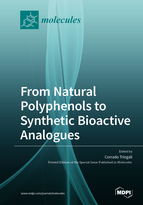From Natural Polyphenols to Synthetic Bioactive Analogues
A special issue of Molecules (ISSN 1420-3049). This special issue belongs to the section "Natural Products Chemistry".
Deadline for manuscript submissions: closed (31 December 2019) | Viewed by 20463
Special Issue Editor
Interests: synthesis of natural-derived polyphenols; low environmental impact reagents and enzymes; isolation and identification of bioactive compounds; extraction and fractionation of biological material from natural sources
Special Issue Information
Dear Colleagues,
In recent years, phenolic compounds from plant sources, commonly referred to as ‘plant polyphenols’, have been the subject of an impressive number of research studies, to a large extent focused on the healthy properties attributed to diet polyphenols, including antioxidant, anti-inflammatory, antineoplastic, antidiabetic, neuroprotective, and other biological activities. Additionally, phenolic compounds isolated from toxic plants and showing cytotoxic or antiproliferative activity have been intensively investigated in view of a possible exploitation of their anticancer properties. In parallel, many research groups have focused their work on obtaining synthetic or semisynthetic analogues of these molecules, with the aim of enhancing their biological activity and possibly improving their metabolic stability and bioavailability, as a first step towards the discovery of new chemotherapeutics agents. The preparation of libraries of analogues derived from natural polyphenols may also contribute to a better understanding of the molecular mechanisms of action of the most promising compounds through structure-activity relationship (SAR) studies. Finally, synthetic compounds inspired to a natural scaffold may also show new and unexpected biological properties.
Thus, this Special Issue aims to highlight the most recent results both in the field of natural polyphenols and in that of their synthetic bioactive analogues. Original articles, as well as reviews, regarding studies on analogues of flavonoids, stilbenoids, curcuminoids, lignans, neolignans and polyphenol-derived compounds are welcome.
Prof. Dr. Corrado Tringali
Guest Editor
Manuscript Submission Information
Manuscripts should be submitted online at www.mdpi.com by registering and logging in to this website. Once you are registered, click here to go to the submission form. Manuscripts can be submitted until the deadline. All submissions that pass pre-check are peer-reviewed. Accepted papers will be published continuously in the journal (as soon as accepted) and will be listed together on the special issue website. Research articles, review articles as well as short communications are invited. For planned papers, a title and short abstract (about 100 words) can be sent to the Editorial Office for announcement on this website.
Submitted manuscripts should not have been published previously, nor be under consideration for publication elsewhere (except conference proceedings papers). All manuscripts are thoroughly refereed through a single-blind peer-review process. A guide for authors and other relevant information for submission of manuscripts is available on the Instructions for Authors page. Molecules is an international peer-reviewed open access semimonthly journal published by MDPI.
Please visit the Instructions for Authors page before submitting a manuscript. The Article Processing Charge (APC) for publication in this open access journal is 2700 CHF (Swiss Francs). Submitted papers should be well formatted and use good English. Authors may use MDPI's English editing service prior to publication or during author revisions.
Keywords
- Polyphenols
- Organic synthesis
- Medicinal chemistry
- Molecular modeling
- Structure–activity relationship (SAR)
- Biological activity
- Bioinspired compounds
- Antiproliferative
- Anti-inflammatory
- Neuroprotective







